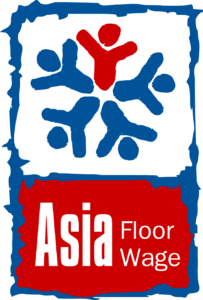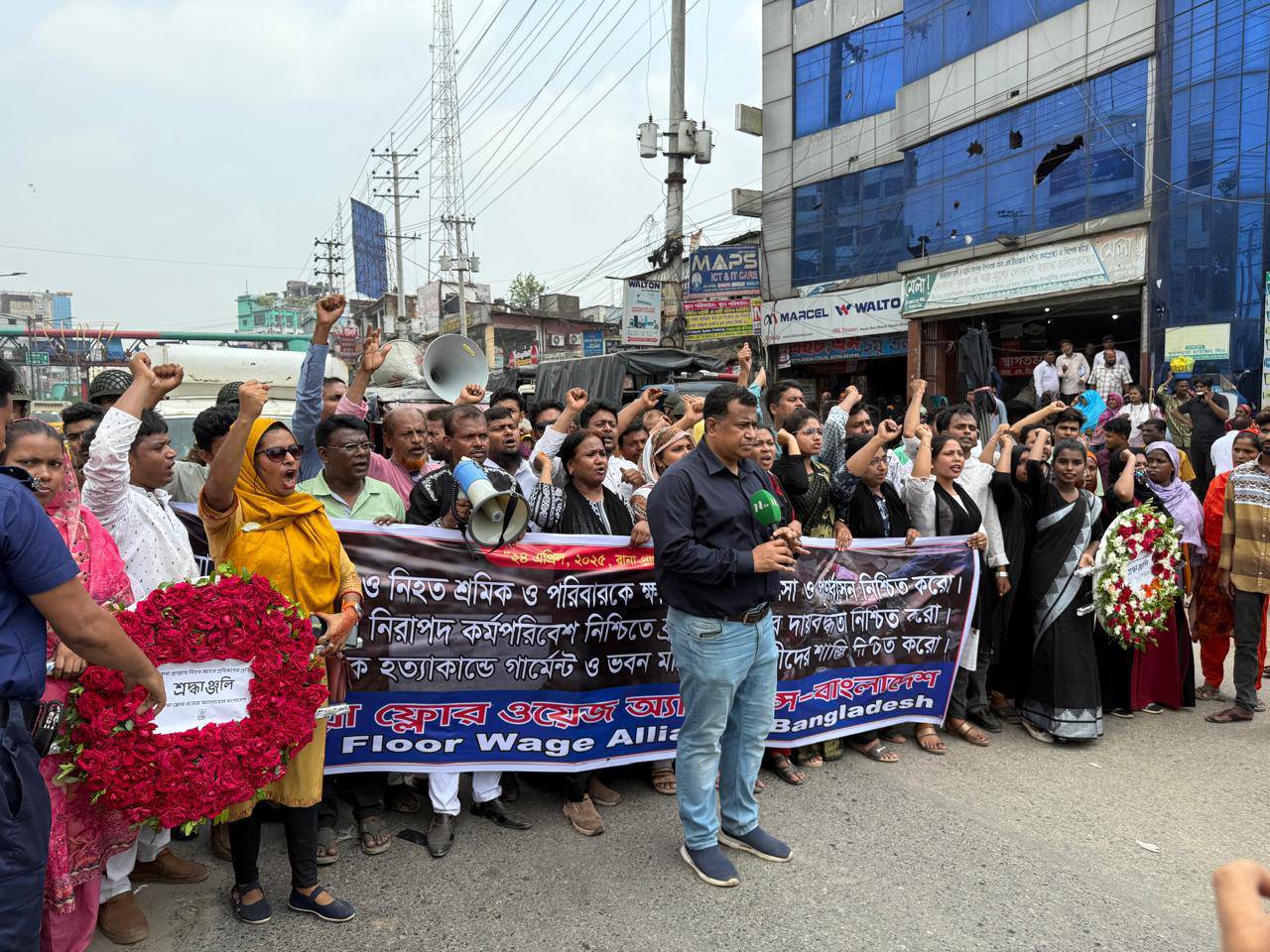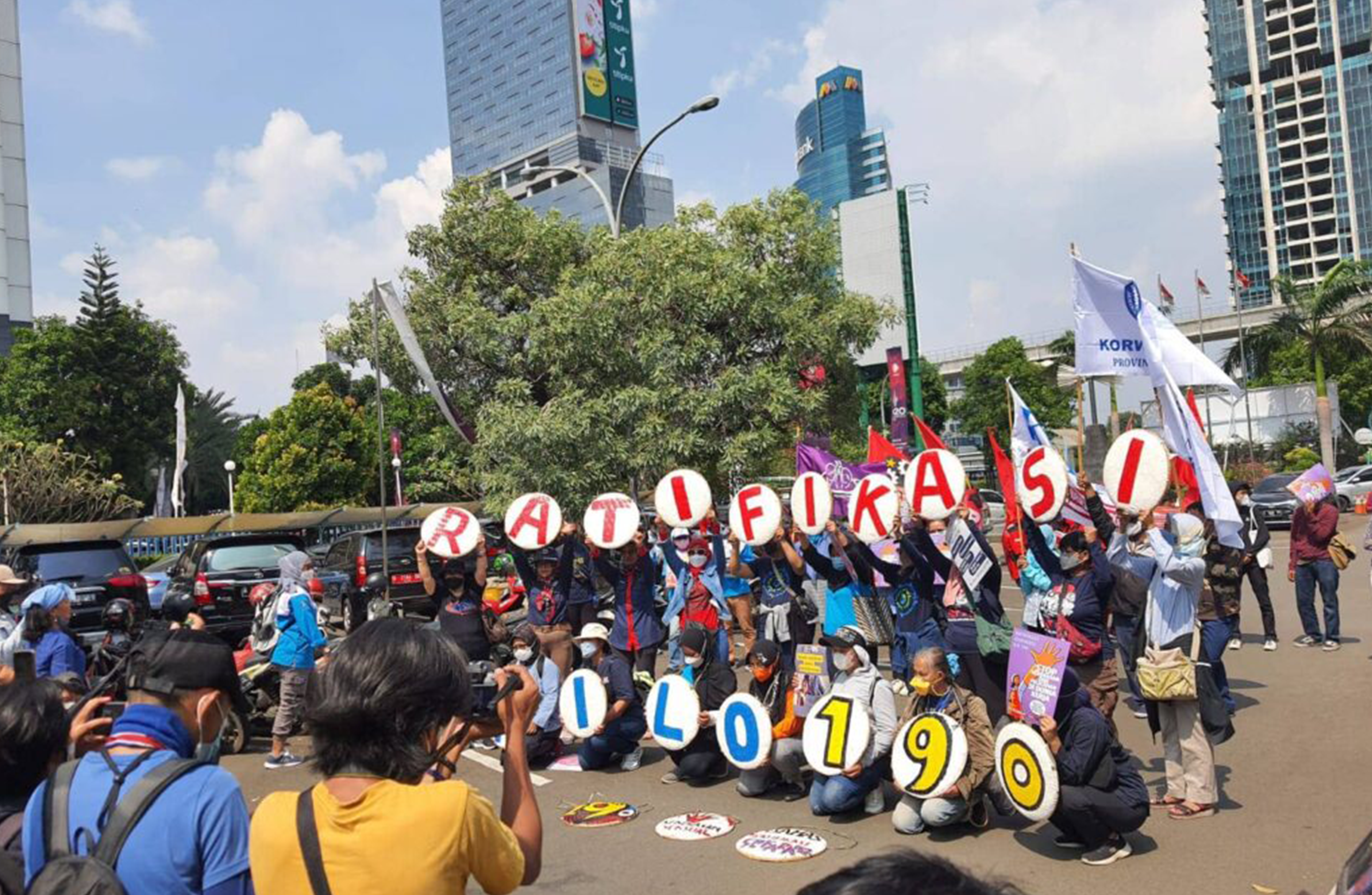Rana Plaza Day 2025: Rallying for Justice, Safety, and Binding Change
Rana Plaza Day has been observed annually since the tragic collapse of the Rana Plaza building on April 24, 2013. Continuing this tradition, AFWA Bangladesh successfully commemorated Rana Plaza Day this year as well. Since 2023, the Alliance has actively marked this day to honor the victims and renew its commitment to workers' rights and safety.
On April 24, 2025, more than 100 leaders and members from ten affiliate organizations of AFWA - Bangladesh participated in the program. The event began at 10:30 AM with a rally in front of the Rana Plaza site, where participants carried banners highlighting key demands related to justice, accountability, and workers’ rights.
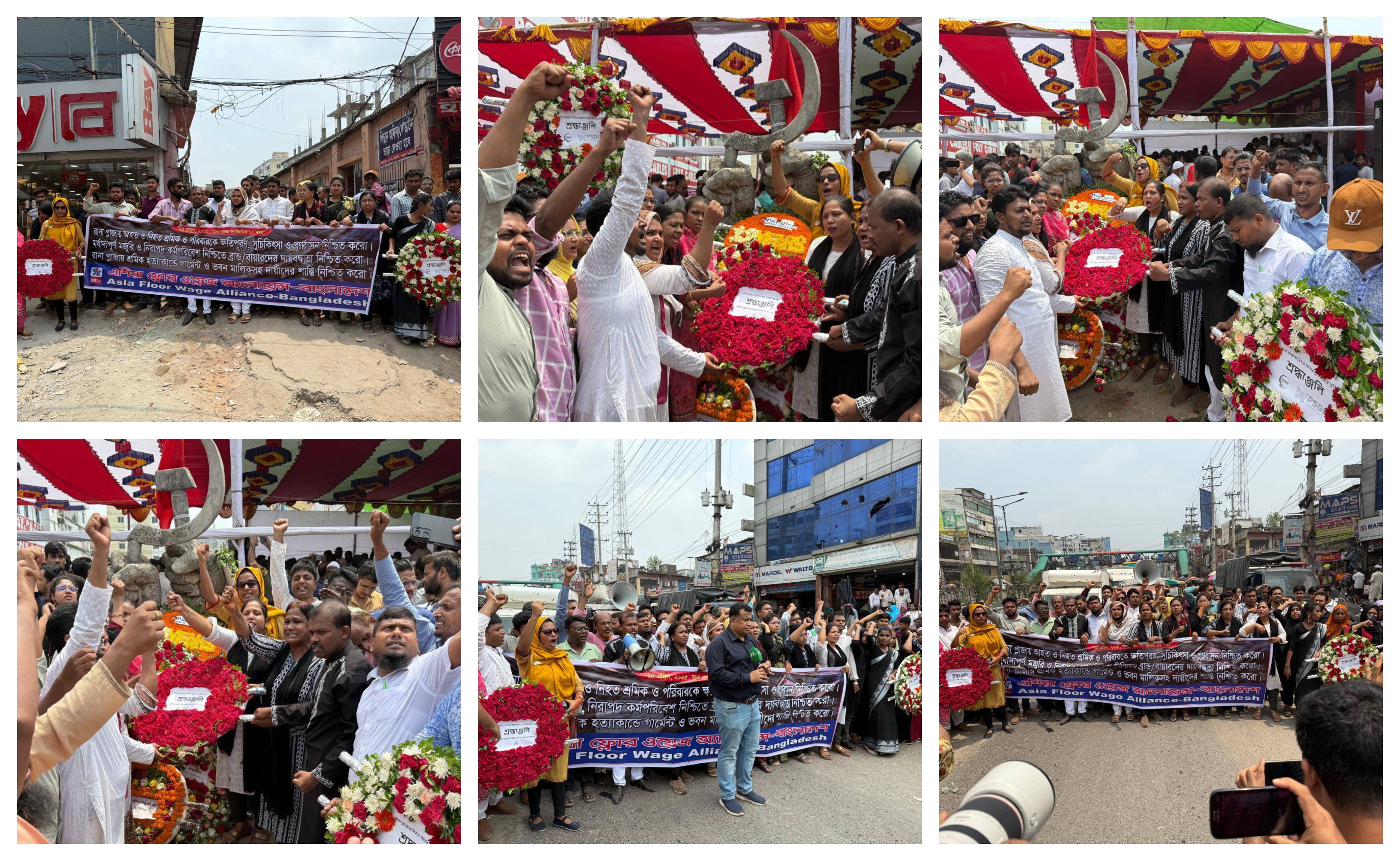 Following the rally, participants paid tribute by laying wreaths at the martyrs' memorial. The commemorative event continued with speeches and slogans focused on the urgent need to fulfill the long-standing demands of workers, ensure justice for the victims, and implement structural changes to prevent such tragedies in the future.
Following the rally, participants paid tribute by laying wreaths at the martyrs' memorial. The commemorative event continued with speeches and slogans focused on the urgent need to fulfill the long-standing demands of workers, ensure justice for the victims, and implement structural changes to prevent such tragedies in the future.
The event was attended by members of the National Committee, Women’s Committee, Youth Committee, and union representatives under the banner of AFWA Bangladesh. Their collective presence demonstrated unity and a strong movement for a safe and dignified garment sector in Bangladesh - where accountability is binding.
Read our full statement here
From Shop Floor to Street Stage: Women Garment Workers Call for Change
 As we step into International Women's Day 2025, the fight against gender-based violence and harassment (GBVH) in the garment industry remains as urgent as ever. Last year, during the 16 Days of Activism, women garment workers in Bengaluru, India, turned their struggles into powerful public performances, demanding justice, safety, and dignity. Here’s how their voices resonated far beyond the factory walls.
As we step into International Women's Day 2025, the fight against gender-based violence and harassment (GBVH) in the garment industry remains as urgent as ever. Last year, during the 16 Days of Activism, women garment workers in Bengaluru, India, turned their struggles into powerful public performances, demanding justice, safety, and dignity. Here’s how their voices resonated far beyond the factory walls.
Written by Suhasini Udayakumar and edited by Lauralyn (Laura)
In an industry plagued by gender-based violence and harassment (GBVH), the rallying cry of women garment workers for safe working conditions, fair wages, and the right to freedom of association has persisted for years. This call was at the heart of the street plays organised between November 25 and December 10 in Bengaluru by Asia Floor Wage Alliance’s (AFWA) National Women’s Leadership Committee. Held to commemorate the United Nations’ 16 Days of Activism against Gender-Based Violence, the campaign added a regional flavour to this global movement.
Street Plays That Brought Hidden Stories to Light
Performed across Magadi, Mysore Road, and Peenya, the initiative was a collaborative effort by AFWA- India and the NGO Munnade, along with the United Garment Workers Union (UGWU), supported by ally Fedina. The 11-minute play, enacted by the Munnade team and AFWA organisers, portrayed the bleak conditions in garment factories, where verbal abuse and sexual harassment are daily realities for women workers.
Calling Out Fashion’s Complicity
The play sheds light on the complicity of fashion brands in perpetuating these exploitative conditions as encapsulated in the cry, “Our labour results in fashion clothes! In profits!”. It also highlighted the oppressive environment on shop floors, where workers are denied basic rights and amenities such as access to drinking water, lunch breaks, and washroom breaks, as denounced by the declaration “Workers are not slaves!”. The discrimination faced by migrant women workers was captured in the demand, “Local or migrant, treat us the same!” and the urgent need for respect and dignity at the workplace as urged in the call, “Keep a hold of your tongue, hand, and eye”. The powerful performance concluded with a resounding call for freedom of association (FOA) to enable collective action for improved working conditions.
A Collective Movement for Change
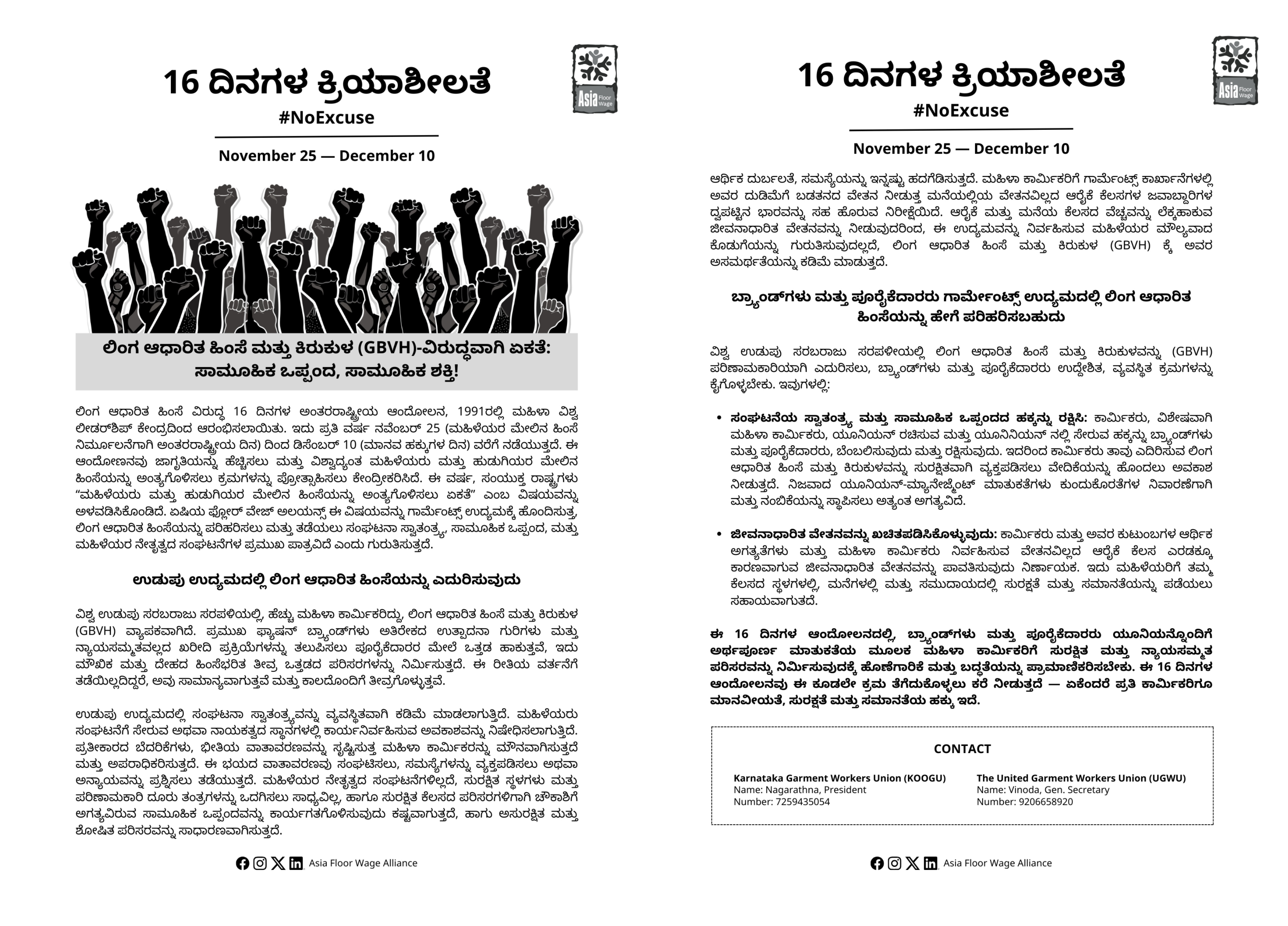 The campaign had a far-reaching impact. Over four public performances, the play was watched by an audience of more than 500 people. Additionally, 24,000 pamphlets on GBVH in the global garment supply chain were distributed, reaching a large number of garment workers and the public.
The campaign had a far-reaching impact. Over four public performances, the play was watched by an audience of more than 500 people. Additionally, 24,000 pamphlets on GBVH in the global garment supply chain were distributed, reaching a large number of garment workers and the public.
This campaign, led by women garment workers, showcased the power of collective action and the importance of solidarity in demanding change. Through their performances, these women transformed their lived experiences into a powerful call for justice, resonating with thousands of workers and the public alike. Their message was clear: respect, dignity, and equality are not privileges but fundamental rights that every worker deserves. This initiative not only underscored the urgent need for reform but also reinforced the strength of unionised voices in shaping a more equitable future.
The Dindigul Agreement at Two Years: A Milestone in Garment Industry Transformation
Two years ago, a tragic event shook the garment industry in Dindigul, India, leading to a groundbreaking movement to end gender-based violence and harassment (GBVH) in the workplace. The #JusticeforJeyasre campaign, ignited by the sexual assault and murder of 21-year-old Jayasre Kathiravel by a male supervisor, culminated in the establishment of the Dindigul Agreement—a legally binding agreement among global fashion brands, suppliers, and unions. This agreement has since become a model for eradicating GBVH, enabling women's agency, and fostering an ethical and equitable work environment in the world of work.
by Sinduri Sappanipillai, Asia Floor Wage Alliance (AFWA)
Lakshmi*, a worker at the Eastman Exports factory in Dindigul, greeted us with a smile that spoke volumes about the transformative power of the Dindigul Agreement. Having worked in the garment industry for over a decade, Lakshmi now engages with her supervisors confidently—a stark contrast to the fear and intimidation that once pervaded the workplace. "We used to see them with fear, but everything changed after the Dindigul Agreement. Now, we look them in the eye and answer confidently," she said.
The Genesis of the Dindigul Agreement
Signed in 2022, the Dindigul Agreement is the first enforceable brand agreement (EBA) in India and a historic milestone in the Asian labor movement. It brought together the Tamil Nadu Textile and Common Labour Union (TTCU), Eastman Exports, Asia Floor Wage Alliance (AFWA), and Global Labor Justice (GLJ), and major global brands like H&M Group, Gap Inc., and PVH Corp. This coalition aimed to create a world of work free from violence and harassment, with a specific focus on the garment industry.
The agreement covers over 3500 workers at Natchi Apparel and Eastman Spinning Mills, the majority of whom are Dalit women. Many of the workers are also young migrants who live in company-owned dormitories and have faced severe discrimination and abuse. The Dindigul Agreement's comprehensive approach, rooted in international labor standards like the International Labour Organization's (ILO) C190 and R206, takes into account women's agency in grievance handling and remediation; as well as ILO #C87 and #98 on Freedom of Association. It also aligns with the Organisation for Economic Co-operation and Development (OECD) guidelines and India's 2013 Prevention of Sexual Harassment (POSH) Act, making it a model for implementing international labor standards in the workplace.
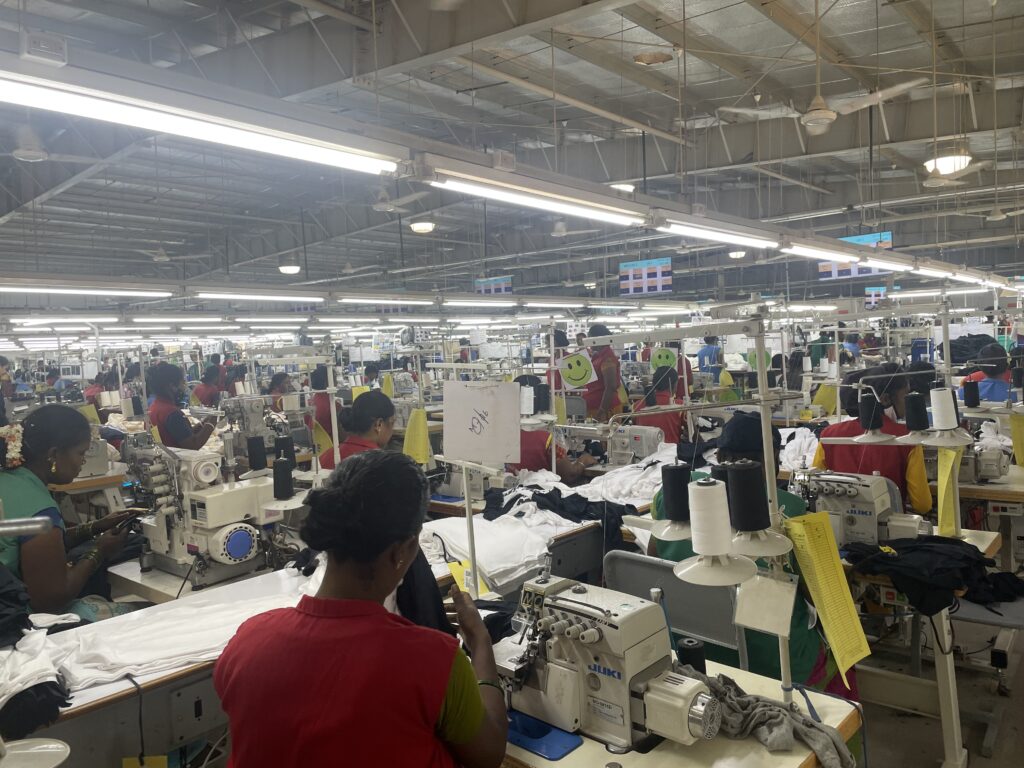
Groundbreaking Mechanisms for GBVH Prevention
The Dindigul Agreement introduced the AFWA Safe Circle approach, a worker and union-led training, monitoring, and remediation program. Worker Shop Floor Monitors (SFMs), trained by TTCU, play a critical role in this system, helping co-workers report GBVH and facilitating regular meetings with management to resolve issues. This proactive approach has led to a significant reduction in GBVH incidents, with 98% of the 185 grievances raised in the first year being resolved, including all 23 GBVH cases.
Read the first year progress report here.
Latha*, a shop floor monitor, highlighted the effectiveness of this system: "Women workers now come forward and share their problems with us, knowing we are here to listen and provide solutions. Any small issue is usually resolved within a few hours. If there's something we can't solve, we bring it to management and ensure it is resolved within 2-3 days."
The agreement has catalyzed profound cultural and behavioral changes in the workplace. Mid-managers and supervisors have significantly altered their behavior towards workers, fostering a more respectful and inclusive environment. This shift has not only improved worker relations but also led to a notable reduction in the factory's attrition rate by 67% between 2021 and 2022, benefiting both workers and business operations. A detailed report of the second year's progress is underway.
The impact of the Dindigul Agreement extends beyond factory floors, contributing to the global effort to eliminate GBVH and other rights violations by enabling women to actively address and prevent instances of GBVH. Women workers in their testimonies share how they found the courage to confront and prevent instances of GBVH in their workplaces, transport facilities, hostels, and communities.
Strengthening FOA and Grievance Mechanisms
Recognizing the essential role of Freedom of Association (FOA) in preventing GBVH, the agreement explicitly protects workers' rights to form and join unions. This protection has enabled workers to speak out and report grievances without fear of retaliation, ensuring timely and effective resolutions.
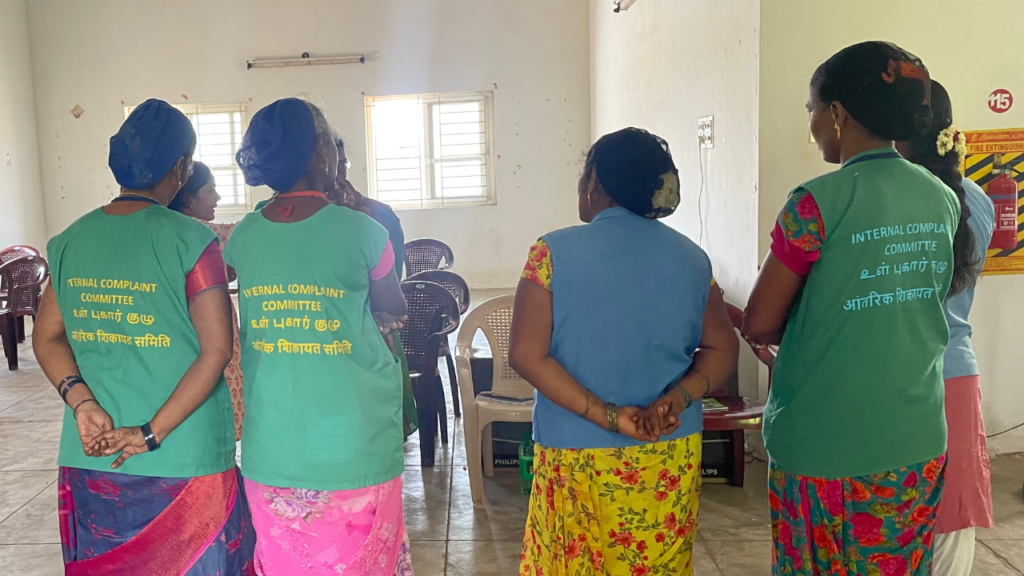
Thenmozhi*, a quality checker at the factory, emphasized the importance of this support system: "Earlier, we were scared, fearing trouble and retaliation for speaking out. But now, we have a support system. We can go to SFMs for any issues, and they resolve them for us. We also have the Internal Complaints Committee (ICC) now. The agreement has helped us understand our rights and has made us confident."
Recommendations for Brands:
Each signatory and stakeholder in the agreement has made measurable and visible contributions:
- AFWA and GLJ have been instrumental in guiding and directing both the union and supplier to ensure the agreement's implementation.
- TTCU has supported SFMs, enabling them to address workers’ concerns and grievances on the shop floor. TTCU also actively engages in resolving worker issues through union-management dialogue.
- Eastman has ensured compliance with remediation efforts and the implementation of corrective action plans.
- Independent Assessors have been involved in strengthening the ICC and ensuring the grievance mechanism is effectively in place.
Going forward, here are some recommendations for brands to take a more visible and active role in the agreement process. They should reward suppliers like Eastman, where worker unions are accepted, and where grievance mechanisms have had unprecedented success in GBVH-related grievance remediation. By prioritizing orders from factories that uphold worker-friendly practices, brands can support and incentivize ethical workplace practices. This visible commitment will send a strong message of support for worker rights and protections, demonstrating a genuine global effort to safeguard worker-driven grievance mechanisms and promote an equitable work environment.
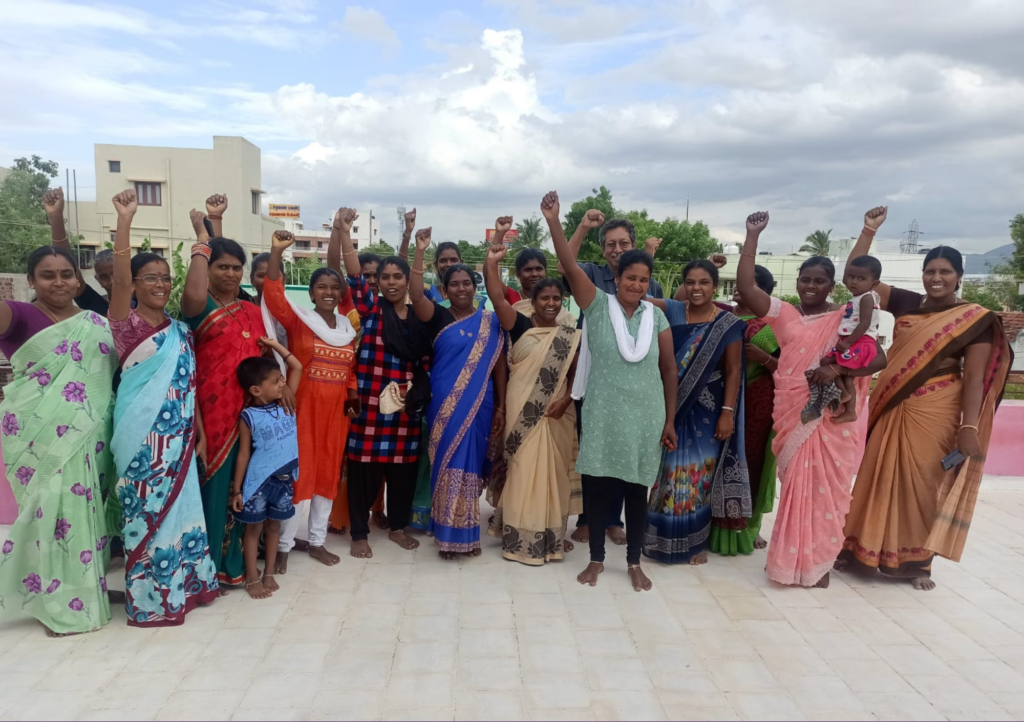
A Call to Action for Global Brands
The Dindigul Agreement has proven to be a transformative model for eradicating GBVH. Its positive impact over the past two years has helped to strengthen workers’ rightful voice at work and fostered a more stable and ethical supply chain. This landmark agreement highlights the need for more brands to support its expansion and replication, ensuring a safe and equitable workplace. The tragic murder of Jeyasre Kathiravel underscores the urgency for such protections, and the agreement's success proves that the industry can evolve for the better, and safeguard the dignity and rights of every worker.
*To protect the privacy of certain individuals, names and identifying details have been changed.
AFWA’s Quest for Living Wages and Gender Equality in the Garment Industry
The Asia Floor Wage Alliance has been a dedicated advocate for living wages in the garment industry since 2007. Its report, released in May 2023, titled "Towards a Woman-Centred Living Wage Beyond Borders," presents an in-depth explanation of AFWA's cross-border living wage methodology.
by Sinduri Sappanipillai, Asia Floor Wage Alliance (AFWA)
The garment industry employs countless individuals globally, with a significant majority being women. Low/poverty wages are an appalling fact of life for these hardworking people in the industry. Minimum wages, in many instances, languish below the poverty threshold, often failing to protect workers from the grim clutches of destitution.
The absence of a sufficient minimum wage results in numerous garment workers having to put in extended hours in order to earn extra pay/over time. This compels them to accept work even when working conditions are unsafe or when they are unwell, as they cannot afford to refuse. Additionally, the meagre wages force these workers to frequently resort to loans simply to make ends meet, leaving them with no savings to rely on in case of unemployment or unforeseen expenses.
Importantly, the financial burden of domestic unpaid labour and caregiving responsibilities, such as childrearing and looking after the elderly, which is typically shouldered by women within households, goes entirely unaddressed. Simultaneously, on the other end, global brands and retailers entrenched within the garment supply chain amass staggering profits. They capitalise on the cutthroat global competition for foreign direct investments, further exacerbating this stark divide between prosperity and hardship.
A living wage is the wage that is necessary for a worker to meet theirs and their family’s basic needs, and have a small amount of savings for unseen circumstances.
The Asia Floor Wage Alliance (AFWA) has been a dedicated advocate for living wages in the garment industry since 2007. Its report, released in May 2023, titled ‘Towards a Woman-Centred Living Wage Beyond Borders,’ presents an in-depth explanation of AFWA's cross-border living wage methodology, which has garnered international recognition and legitimacy since its public announcement in 2009.
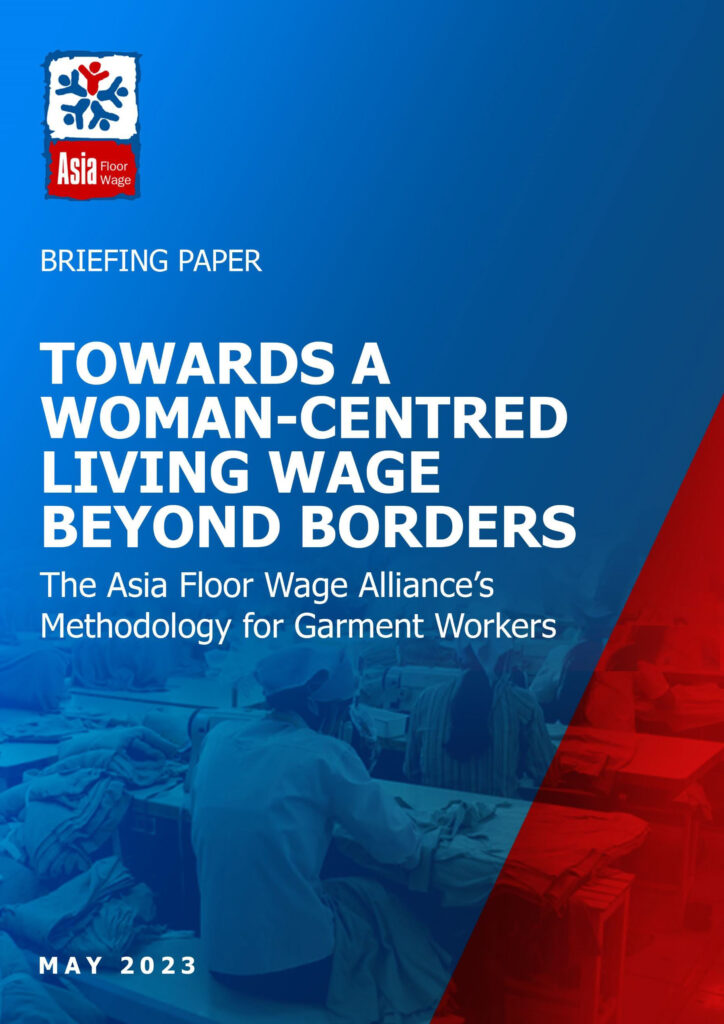
Debate and history - Minimum wage vs Living wage
The debate surrounding living wages in labour-intensive industries has regained prominence over the past two years. Historically, the International Labour Organisation (ILO) has played a crucial part in proposing conventions and recommendations to both developed and developing nations regarding the establishment of mechanisms and frameworks for determining minimum wages. The concept of a “minimum living wage” was introduced by the ILO, encompassing both the minimum level of remuneration and an acceptable standard of living. Initially, the emphasis leaned toward the former (”minimum”) and became intertwined with the World Bank's poverty alleviation program. However, it remained confined to this trajectory, failing to reach a universally acceptable standard of living for all workers.
AFWA’s approach to advocating for living wages
Before the inception of AFWA, brands within global garment supply chains had pre-established responses to garment workers' demands for living wages. They often asserted that they were already paying living wages, exploiting the confusion between minimum and living wages. Some would argue that there was no unified definition of a living wage within the labour movement, making it impractical to implement. AFWA reintroduced the concept of the "minimum living wage," and transformed the minimum living wage into an actionable concept and initiated a regional strategy by developing a consistent benchmark for living wages across borders. This explained the disparity between living wages and minimum wages, and revealed that the latter barely surpassed the poverty threshold.
The Asia Floor Wage (AFW) concept was developed as a regional wage formulation demand that would serve as a living wage in garment industry manufacturing in Asia. The methodology is significant for several reasons:
In AFWA’s methodology, a living wage is based on the needs of workers and their families, known as the “family wage”. This family-centric approach ensures that the living wage estimation aligns more accurately with the actual needs of workers and their families.
AFWA recognises that families come in varying sizes and compositions. Based on a survey of family sizes in Asia, AFW is based on a family comprising 3 adult consumption units. Each adult in a household is treated as 1 consumption unit and every child as half a consumption unit. Therefore, 3 consumption units can include 1 worker and 2 adult dependents, 2 adults and 2 children, or 1 adult and 4 children.
AFW is anchored in food costs based on the internationally accepted Engle’s Law that shows that lower-income countries (in this case, garment production countries) spend more on food costs than higher income countries. AFW is based on an adult, engaged in physical labour, needing 3,000Kcal a day to perform their work effectively (using the benchmark set by the Indonesian government). The ILO has recently confirmed this 15 years after AFW was first made public in 2009. In 2022, the ILO’s report on minimum wage methodology defined 2950 calories as the norm. AFWA calculates the living wage for a family in the garment industry by scaling up the monthly total of food and non-food costs by 3 consumption units.
AFWA's living wage methodology is a blend of bottom-up and top-down approaches. It draws on need-based surveys conducted among garment workers across various Asian countries, leveraging workers' unions and associations for labour organisation and negotiation with global brands regarding living wages.

Women-centred approach
AFWA's definition of a living wage adopts a women-centred perspective by steadfastly assuming a single-earner family for a standard 3-consumption family unit. This ensures a specific earner dependent ratio (1:3) which recognises the importance of unpaid household work, including care work, which is vital for families and primarily carried out by women, making it unique from any other existing methodologies.
A right to living wage
The estimation of a living wage is independent of the number of hours worked per day or per week. Given the prevalence of overtime work in the garment industry, it is vital that the living wage is based on a minimum number of working hours or a standard working week. AFWA determines the standard to be no more than 48 hours a week, 8 hours a day considering the 6-day workweek in the garment industry to cover basic needs and provide a decent standard of living.
In contrast, the current reality of garment workers is that most of them work long hours (often exceeding 10 hours per day) to inch their income just above the unsustainable poverty-level minimum wage. This situation perpetuates a cycle of debt and financial insecurity, as the wages earned are often insufficient to meet the basic needs. For instance, at the outset of the pandemic, brands abandoned workers in their supply chains and women were left to fend for themselves and their families through any means, which entailed reducing their consumption, taking on huge debt, and selling meagre assets to cover the costs of basic survival.
It is crucial to note that the living wage is exclusive of benefits and allowances such as healthcare, pension, provident fund, overtime wages and performance allowances. Given that the employers in the Asian garment factories generally do not bear these costs, it becomes important that the living wage is sufficient to meet basic needs regardless of employers' contributions.
Cross-country approach
AFWA's analytical approach and strategy have culminated in a methodology for formulating the unique cross-border living wage at the Asia level. The advocacy strategy hinges on a comprehensive analysis of power dynamics within the global garment supply chain, urging apparel brands to shift from coercively suppressing labour costs to progressively realising a living wage by adjusting their pricing mechanisms with suppliers. AFWA's regional living wage formulation alleviates a significant concern in production regions—the threat of brands relocating their operations and pitting one country against another.
Importantly, AFWA's living wage methodology offers a regionally tailored solution that carefully aligns with national economies without disrupting their competitiveness. The AFW concept uses the World Bank’s purchasing power parity (PPP) dollar as a common currency to compare a regional or cross-country floor for living wage.
AFW - Survey and findings
AFWA regularly updates the Asia Floor Wage (AFW), which represents the living wage, using food basket surveys conducted in various production countries across Asia. Additionally, more recently, AFWA has been conducting comprehensive consumption surveys. The latest survey - Household Consumption Expenditure Survey (HCES) was conducted in 2022.
The Findings
The calculation of the food cost is based on the daily caloric needs of an adult worker engaged in physically demanding work, set at a standardised value of 3000 calories. The non-food costs, encompassing expenses such as housing, clothing, healthcare, reproductive health, fuel, transportation, education, and more, are simplified in the AFW by representing them as a factor of the food cost. The ratio of food to non-food costs is 45:55, and this adjustment was reaffirmed in 2022.
The report's findings are based on surveys conducted with 1686 garment workers across seven countries: Bangladesh, Cambodia, Indonesia, India, Myanmar, Pakistan, and Sri Lanka, spanning 206 garment factories. The majority of those surveyed were women aged between 18 and 49, many of whom were responsible for supporting families with children under the age of 15. The Household Consumption and Expenditure Survey (HCSE) employed a structured interview schedule to gather data on consumption levels, categorised into six sections: (1) Basic worker profile, (2) Employment details, (3) Food consumption and related expenses, (4) Non-food consumption and related expenses, (5) Ownership of assets, and (6) Housing and living conditions.
The industry predominantly employs young workers. This raises significant concerns regarding the future prospects of women workers after they are pushed out of the industry at middle age, often with little or no social security and no savings due to having earned only poverty level minimum wages.
Differences in family size among workers across various countries are notable, with Indonesia having the lowest average family size at 3.6 and Pakistan registering the largest at 5, making it challenging for women workers to live with minimum wages. For example - In Pakistan, where the average family size is 5, women often face significant challenges as they are frequently the primary breadwinners earning minimum wage salaries. Additionally, 46% of households in Pakistan have at least one child aged 6-18 years, and 54% have children below the age of 6, making it even more challenging for women to provide for larger families while taking care of their children and households.
Despite the diverse composition of the garment workforce in each country, a striking similarity emerges in terms of cost-of-living expenditures and the constituents of both food and non-food items across the Asian region. This similarity justifies the selection of Asia as the unit of analysis for establishing a 45:55 ratio between food and non-food items, thereby enabling the creation of a consistent and regionally equivalent standard for estimating living wages.
A significant proportion of the workforce are engaged in temporary, casual, or irregular employment, with predominant presence of women with more dependents, and a lack or insufficiency of social security benefits.
The caloric statistics and the substantial disparities observed throughout the region give rise to profound concerns. For instance, in Sri Lanka, survey respondents reported consuming an average of 1834 Kcal/day at a cost of 271 LKR per day, which is among the lowest recorded figures. These consumption figures fall significantly below the international poverty thresholds, painting a stark and troubling picture of the widespread poverty and hunger that persists within the industry due to the current wage structures.
There is limited asset ownership, a prevalence of rented housing or a lack of ownership of homes or land, and restricted access to essential amenities such as sanitation facilities, and adequate healthcare infrastructure in urban areas.

Imagine the impact of having a living wage. Instead of working excessive hours just to make ends meet, the workers, predominantly women, would be able to earn a fair wage in a 48-hour workweek. The additional few hours of free time would be transformative, in terms of quality of life. This means having the opportunity to spend more time with their children and family, being present for important moments in their children's lives, nurturing and supporting them. They can have the joy of seeing their children grow, helping with homework, playing together and fostering strong family bonds while pursuing their own passions and interests.
Further, an extra few hours in terms of money can have a profound impact on the quality of life. It means being able to afford essential items like nutritious food, safe housing, and reliable transportation and healthcare.
As a reader, take a moment and share your thoughts on what having a living wage means to you. How does it enhance your life? How does it feel to have the financial stability to spend more time with loved ones, pursue your passions, or engage in activities that bring you joy? Feel free to share your thoughts and experiences!
Garment Workers in Asia Need ILO Convention 190
“Ijah, you know, right, if you take maternity leave, your contract will expire? So don’t even think of taking maternity leave," said the factory supervisor one afternoon when Ijah was about to leave her line to rest.
"I don't understand, ma'am. You cut my wages and my menstrual leave compensation after my pregnancy started showing,” Ijah cried, frustrated that she wasn’t even getting to rest during her pregnancy. However, the supervisor insisted that Ijah wouldn’t be able to take her maternity leave because her contract would expire. Indonesia’s labor law stipulates three months of maternity leave, but Ijah’s contract would have ended by the time she is due.
Ijah has been working as a contract worker since she was a young woman in the Cakung Industrial Area in North Jakarta, Indonesia. She is now 35 years old, married with two children and a third on the way, and still hasn’t received ‘permanent worker’ status.
This is due to a common but illegal practice in Indonesia's garment industry where factories frequently hire workers for no longer than three months at a time. Consequently, employees like Ijah are forced to move from one factory to another without severance pay, often working anywhere from 30 days to 3 months at each location. A significant number of these workers are women who, consequently, are forced to forfeit essential social security benefits such as menstrual and maternity leaves. Ijah, like many others, can only hope her contracts are repeatedly renewed until she gets old and weary.
When fashion companies in the Global North started to look for labor markets in the Global South, the garment sector was positioned as a promise of economic and social upliftment for millions across Asia. However, the industry has become a hotbed of gender-based violence and harassment (GBVH), particularly for women. A recent global International Labour Organization (ILO) study found that 22.8% or 743 million persons in employment had experienced at least one form of violence and harassment at the workplace. While data on sexual violence is scarce, more so at the regional level, available studies indicate particularly high rates in some countries.
In 2021, the ILO Better Work program reported that approximately four out of every five workers in Indonesian factories expressed concern about sexual harassment at work. In the same study, 42.5% of women workers from Myanmar said they had been sexually harassed at work. In Vietnam, 19.8% of female workers and 11.9% of male workers reported that they had experienced at least one form of violence in the previous six months (CARE International 2020).
C190: Promise of a safe work environment
The ordeals that Ijah and countless other garment workers have to endure, day in and day out, teeter on the line of outright violence and incessant harassment. It is a stain on human rights that such flagrant violations persist globally, not only in the workplace but also in homes and public spaces. The cost is not just economic; it seeps into the very fabric of our societies, burdening individuals, families, and entire communities. The bleak reality is that these abuses persist, unchecked and unimpeded, despite their clear illegality, with emboldened perpetrators taking advantage of the fear of the most vulnerable of workers.
Everyone is entitled to a workplace where dignity and safety aren't mere luxuries but inherent rights. This includes freedom from violence and harassment of any kind, especially when it's gender-based.
Recognizing this right as paramount, the ILO, in June 2019, adopted the first international treaty on workplace violence and harassment – Convention 190 (C190) and its accompanying Recommendation 206 (R206). The treaty came into effect on 25 June 2021.
Governments pledging support to C190 have a duty to enact necessary laws and policies to counter and eliminate workplace violence and harassment. The treaty rightly identifies women and other vulnerable groups as being at an escalated risk of these rights abuses – a reality that is particularly acute during times of crises, like a global pandemic. It thus calls for an inclusive, gender-sensitive, and integrated approach to put a definitive end to all forms of violence and harassment at work.
C190 and R206 represent a historic chance to mold a future of work that is rooted in dignity and respect for everyone. But, even two years after its inception, the journey to realizing safe and GBVH-free workplaces remains daunting. It's disheartening that in Asia, not a single country has embraced C190 and R206. Local laws may exist on paper in these nations, promising protection to workers, but they're routinely overlooked or breached – all for the sake of productivity and profit.

Let’s take a quick look at the state of affairs in some of the major garment-producing markets in South and Southeast Asia.
Indonesia:
Between 2020 and 2021, the Central Board of Serikat Pekerja Nasional (SPN), Lembaga Informasi Perburuhan Sedane (LIPS), and the Workers' Rights Consortium (WRC) conducted a study of 12 garment supplier factories in Java Island and found that the most prevalent types of GBVH included:
- Verbal violence (yelled at, rudely called, insulted, threatened, asked out to date, seduced, sexual chat)
- Physical violence (hit, kicked, grabbed, thrown, poked with fingers, touched, hugged, peeked at, buttocks grabbed, bra straps pulled)
- Other forms of violence such as physical punishment, increasing production targets or working hours, and withholding maternity leave and menstrual leave
Although the study doesn’t give sexual violence its own category, under the definition given by ILO C-190, actions like ‘asked out to date, seduced, sexual chat’ and ‘poked with fingers, touched, hugged, peeked at, buttocks grabbed, bra straps pulled’ would constitute forms of sexual violence.
“GBVH is corrosive to women workers’ sense of self and makes them voiceless and powerless, while also becoming a barrier to their accessing other fundamental rights such as freedom of association and living wage,” says Sumiyati, Chair of SPN Women’s Committee and member of AFWA Women’s Leadership Committee (WLC). Fashion brands must make concrete commitments to understanding and addressing risk factors for GBVH across their supply chains through a ground-up approach that upholds respect for freedom of association and is led by workers and trade unions (AFWA, 2021). Sumi continues, “Factories need to be converted into GBVH-free zones, but workers cannot do this alone.”
Sri Lanka
GBVH prevalence in Sri Lankan workplaces stems from patriarchal norms, power imbalances, gender equality ignorance, lax policy enforcement, and insufficient victim support. These issues are exacerbated by hierarchical work structures where those in power exploit their authority. Although the government has legislated protections such as the Employment of Women, Young Persons, and Children Act, the Penal Code, and the Sexual Harassment Act, their enforcement is often inconsistent.
A 2021 study by AFWA on GBVH during the COVID-19 pandemic found that many young mothers had been forced to resign after the factory they worked in refused to reopen the creche. Many others had to leave their children in their village homes, to be cared for by elderly parents, while they went to the city for work.
Various NGOs, trade unions, and civil society groups in Sri Lanka are actively working to combat GBVH by raising awareness, offering victim support, advocating policy changes, and promoting gender equality through training and capacity building. Efforts to foster safe, inclusive work environments via gender-sensitive policies, awareness campaigns, and stakeholder training are underway.
Cambodia
In 2019, the Garment, Footwear, and Travel Goods sectors contributed 57% to Cambodia's total exports and employed 808,223 workers, 80% of whom were women. These workers, primarily rural migrants, often endure substandard living conditions in city rentals marked by poor hygiene, high costs, and low security. Despite their significant presence in these industries, female workers face hardships due to their limited education and societal norms. The persistence of male dominance, particularly in higher positions within factories, further exacerbates their plight.
A 2021 study by AFWA found that Cambodian workers were too afraid to take bathroom breaks for fear of verbal abuse if their daily production targets were not met. They would limit themselves to a single break per day, hold in their urine for a long time, or even restrict water intake, despite being aware of the risk of urinary tract infections or suffering regular stomach and bladder pain.
In another instance, all workers received less than half of the monthly minimum wage when work was suspended after brands cancelled or reduced orders during the pandemic. Women workers were disproportionately impacted by the illegal wage deductions and didn’t even receive the monthly US$70 mandated by the government.

India
India's struggle with gender inequality and violence against women extends into workplaces, particularly the female-dominated garment industry. Fear of backlash, social stigma, and unawareness of their rights often discourages victims from reporting harassment, perpetuating a culture of silence.
Several legislative measures exist to combat these issues:
- The Sexual Harassment of Women at Workplace Act (POSH), 2013, mandates safe working conditions and complaint-handling mechanisms.
- The Factories Act, 1948, establishes health and safety standards in garment factories.
- The Maternity Benefits Act, 1961, provides protections for pregnant and new mothers.
- The National Policy for Women, 2016, aims to tackle gender disparities and foster safe work environments.
However, enforcement gaps and patriarchal attitudes hinder the effectiveness of these laws. Various government bodies, NGOs, and industry stakeholders are working to raise awareness and increase sensitivity towards these issues. More recently, increasing emphasis has been placed on addressing workplace GBVH, including in the garment industry. At the same time, greater effort needs to be put into creating safe and inclusive environments for women, strengthening law implementation, and promoting gender equality.
One successful effort towards this is the Dindigul Agreement to Eliminate Gender-based Violence and Harassment. In April 2022, Indian women- and Dalit-worker-led union TTCU signed a historic agreement with clothing and textile manufacturer Eastman Exports to end GBVH at Eastman Exports’ factories in Dindigul, in the southern state of Tamil Nadu in India. TTCU, GLJ-ILRF, and AFWA also signed legally binding agreements with multinational fashion companies and their supplier to build a safe and GBVH-free workplace or impose business consequences on the supplier in the case of violations. Enforceable brand agreements, in which multinational companies legally commit to labour and allies to use their supply chain relationships to support a worker- or union-led program at certain factories or worksites, have proven effective in holding brands and suppliers accountable for workplace safety.
Vietnam
Vietnam legally prohibits violence, including sexual harassment, both at home and work. This is enshrined in the Domestic Violence Prevention and Control Law of 2007 and the 2012 Labour Code, which explicitly bans workplace sexual harassment.
However, the National Study on Violence Against Women in 2019 found that 62.9% of women had experienced at least one form of physical, sexual, emotional, and economic violence, and controlling behaviors by their husbands in their lifetime; 31.6% had experienced the same in the previous 12 months. In addition, the study showed 13.3% of women suffered sexual violence by a husband/partner in their lifetime and 5.7% in just the last 12 months.
There is no specific data on violence, including sexual violence, and harassment at the workplace, but some experts believe it to be higher than the 23% stated in a 2022 ILO study. Gaps in the policy and in its implementation and enforcement as well as the deeply ingrained patriarchal culture are among contributing factors to the problem.
In an article published in March 2023 by the Vietnam General Confederation of Labour (VGCL) mouthpiece, a representative said that the country should review and pass the ILO C-190 because it would act as a foundation for any policy to eliminate violence and harassment, including GBVH, at the workplace.
Pakistan
Pakistan's garment industry is the country's second-largest employer, providing jobs for 15 million people, accounting for 38% of its manufacturing labour force, 8.5% of its GDP, and almost 70% of its exports. Around 20% of the country’s garment factories produce readymade garments for US and European markets. A significant number of garment workers are women, who face numerous challenges including pay disparity, limited leadership opportunities, and pervasive GBVH. In 2022, Pakistan was ranked 145 out of 146 countries in the World Economic Forum's global gender gap report, making it the second worst in gender parity.
In 2010, Pakistan introduced the Protection against Harassment of Women at the Workplace Act, necessitating every organization to have an Internal Complaints Committee (ICC) for handling complaints linked to GBVH, but implementation gaps persist due to systemic issues, structural inequalities, cultural norms, inadequate worker awareness, inadequate training for ICC members, fear of employer retaliation, and mistrust in the justice system. In 2022, the act was amended, expanding the definition of workplaces to both formal and informal settings and strengthening protections for victims of sexual harassment, including ensuring confidential reporting mechanisms, protection against victimisation or retaliation, and access to support services such as counselling and legal aid.
These recent amendments reflect a commitment to strengthening the legal framework surrounding sexual harassment in Pakistan but successful implementation depends on collaborative efforts from all stakeholders and continued vigilance to ensure safe and inclusive working environments, especially for women.
Bangladesh
The garment industry in Bangladesh is one of the largest in the world, employing millions of workers, a majority of whom are women. Unfortunately, these workers are vulnerable to various forms of gender-based violence, including sexual harassment, assault, and exploitation. The Bangladesh government has recognised the severity of GBVH in the workplace and has taken legislative measures to address the issue:
- The Bangladesh Labor Act (2006): This law defines sexual harassment and outlines procedures for filing complaints and conducting investigations in workplace harassment cases in all sectors, including the garment industry.
- The Bangladesh Labor Rules (2015): These rules supplement the Labor Act and require employers to establish appropriate mechanisms, such as complaint committees, to handle complaints effectively.
- National Tripartite Plan of Action (NTPA) on the Elimination of Violence against Women and Children in the Workplace: The government, in collaboration with worker and employer organisations, developed the NTPA to address create safe working environments, raise awareness on GBVH, provide support services, and strengthen legal and policy frameworks.
Despite these measures, implementation and enforcement of existing laws and codes of conduct are inconsistent and there is limited awareness among workers about their rights — the lack of available mechanisms for reporting further compounds the problem.
Lack of worker-led initiatives increases the risk of GBVH
To prevent and eliminate GBVH, freedom of association is absolutely necessary. Survivors of GBVH often refrain from reporting incidents or accessing grievance redressal mechanisms due to fear of retaliation or lack of trust in the management, and worker-led labor unions protect workers from such backlash.
Not only have fashion brands’ voluntary codes of conduct and corporate social responsibility (CSR) initiatives failed to ensure GBVH-free workplaces, their purchasing practices have increased the risk of GBVH. The garment global supply chain is structured such that brands have all the market power. They do not produce garments, they source their products from companies and factories, normally in low- and middle-income countries. Business relationships between brands and suppliers are governed by purchasing practices that impact the functioning of supplier firms and, in turn, working conditions in these firms. As a result, brands are able to pressurise suppliers to reduce costs and increase production targets. This high-pressure model leads to an environment where bullying and GBVH are used as tactics to speed up production and discipline workers, while also deterring them from joining unions and reporting labour violations.
The absence of brand governance and accountability in preventing and eradicating GBVH in garment factories has led to crippling debt and hunger for women workers due to insecure employment and wages. This financial instability exacerbates their already significant burdens, intensifying the violence and harassment they encounter both at work and at home.
To counter these governance gaps within global garment supply chains, AFWA has collaborated with trade unions to devise a joint employer liability legal strategy, which targets brands that evade legal responsibility for harmful purchasing and other practices that foster conditions conducive to GBVH in their supplier factories.

The need for C190
While existing laws partially address GBVH, they often fall short of the standards set by ILO's C190, with a limited scope and emphasis on punishment over prevention. Enforcement is weak and doesn't extend to temporary or contract workers (in the informal category of workers), including those working from home. Ratifying and implementing C190 and R206 would bolster legal frameworks, compelling countries to provide comprehensive remedies for survivors, including all workers, even those commuting or migrating for work. Importantly, this legislation also recognises the relationship between domestic violence and workplace concerns.
C190 fosters gender justice and empowers women by protecting them from violence and harassment, enabling them to participate actively in unions and report incidents confidently. Both C190 and R206 recognise economic harm as violence, offering a gender-inclusive approach to addressing workplace violence. It specifically looks to address risks from discrimination, power imbalances, and occupational health and safety issues.
Labour and feminist movements must unite to push for the ratification of ILO's C190 and R206. Trade unions can use these guidelines in collective bargaining and enforceable agreements with suppliers and brands to implement worker-led prevention of GBVH, as seen in instances like the Dindigul Agreement in Tamil Nadu, India.
Existing policies protecting workers’ rights are often weak and inconsistent. Brands exploit these gaps, frequently changing suppliers for cost benefits. To compete for orders, countries sometimes overlook worker benefits, necessitating a regional approach to worker protection. C190, the first international labour standard offering a framework to tackle workplace violence, including GBVH, is essential. It legally recognises the right to a violence-free workplace and sets out the obligation to respect, promote, and realise this. C190 encourages international cooperation and knowledge exchange, contributing to global women worker protection. Hence, we call for countries to ratify ILO's C190. Everyone is entitled to a workplace where dignity and safety aren't mere luxuries but inherent rights.
